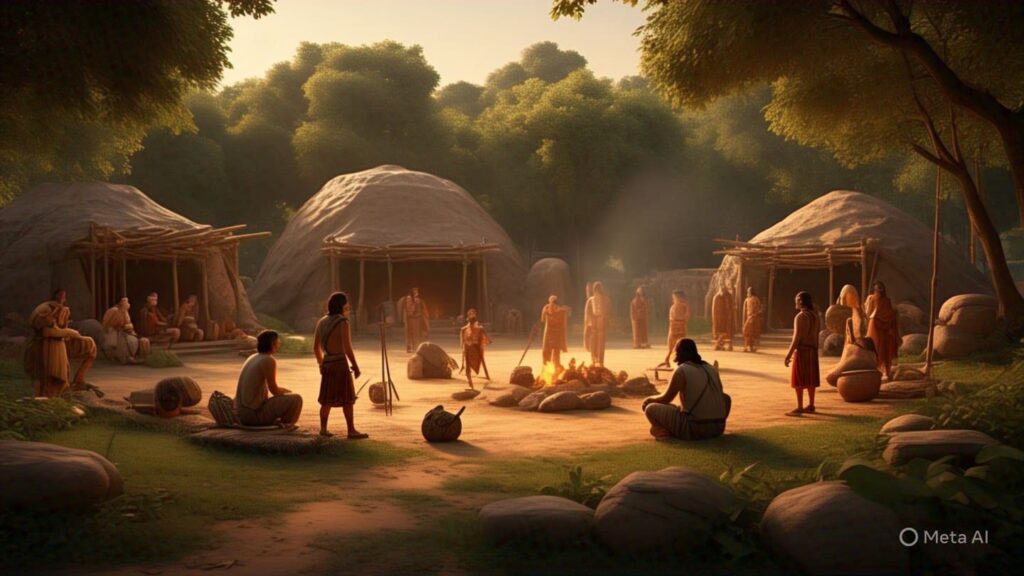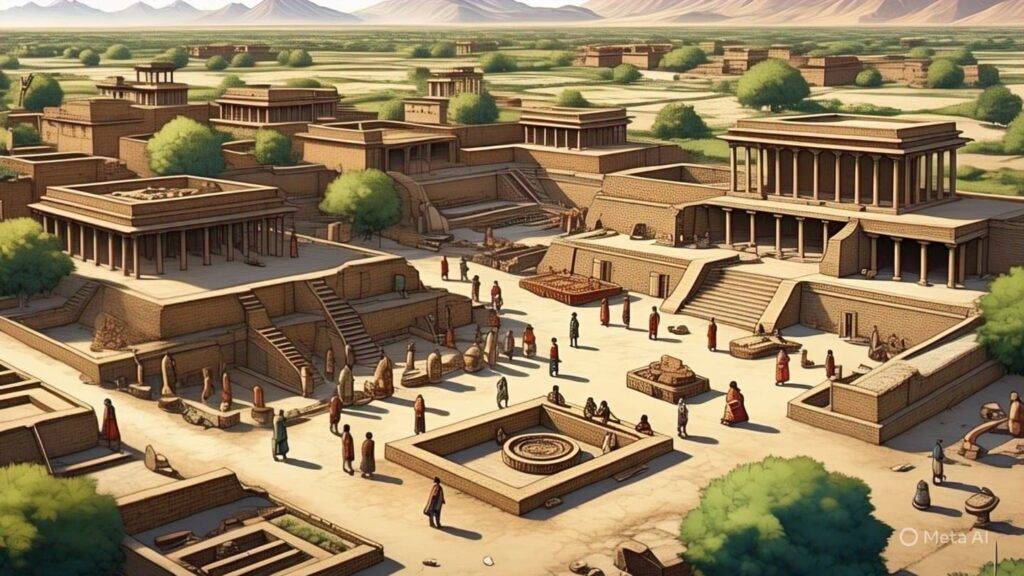Rig Vedic Period (Early Vedic Period)
- Q: ऋग्वैदिक काल में मुख्य धर्मग्रंथ कौन सा था? (What was the main religious text in the Rig Vedic period?)
Ans: ऋग्वेद (Rigveda). - Q: ऋग्वैदिक समाज में मुख्य आजीविका क्या थी? (What was the primary occupation in Rig Vedic society?)
Ans: पशुपालन और कृषि (Cattle rearing and agriculture). - Q: ऋग्वैदिक काल में परिवार का मुखिया कौन होता था? (Who was the head of the family in the Rig Vedic period?)
Ans: पिता (Father). - Q: ऋग्वैदिक काल में प्रमुख देवता कौन थे? (Who were the main gods in the Rig Vedic period?)
Ans: इंद्र, अग्नि और वरुण (Indra, Agni, and Varuna). - Q: ऋग्वैदिक समाज में वरना व्यवस्था किस आधार पर थी? (What was the Varna system based on in Rig Vedic society?)
Ans: कर्म और गुण (Occupation and qualities). - Q: ऋग्वैदिक काल में विवाह की प्रमुख प्रथा क्या थी? (What was the main marriage practice in the Rig Vedic period?)
Ans: स्वयम्वर और मोनोगैमी (Swayamvara and monogamy). - Q: ऋग्वैदिक काल में धन का प्रमुख रूप क्या था? (What was the main form of wealth in the Rig Vedic period?)
Ans: पशुधन (Cattle). - Q: ऋग्वैदिक काल में राजा का चुनाव कैसे होता था? (How was the king selected in the Rig Vedic period?)
Ans: जनसभा के माध्यम से (Through the tribal assembly). - Q: ऋग्वैदिक काल में मुख्य उत्सव कौन से थे? (What were the main festivals in the Rig Vedic period?)
Ans: यज्ञ और धार्मिक अनुष्ठान (Yajna and religious rituals). - Q: ऋग्वैदिक काल में महिलाएं कैसी स्थिति में थीं? (What was the status of women in the Rig Vedic period?)
Ans: सम्मानजनक और स्वतंत्र (Respectable and independent). - Q: ऋग्वैदिक काल में सामाजिक व्यवस्था कैसी थी? (What was the social structure like in the Rig Vedic period?)
Ans: जनजातीय और समानता आधारित (Tribal and egalitarian). - Q: ऋग्वैदिक समाज में सभा और समिति का क्या महत्व था? (What was the importance of Sabha and Samiti in Rig Vedic society?)
Ans: शासन में निर्णय लेने के लिए (Decision-making in governance). - Q: ऋग्वैदिक काल में शिक्षा का माध्यम क्या था? (What was the medium of education in the Rig Vedic period?)
Ans: मौखिक परंपरा (Oral tradition). - Q: ऋग्वैदिक काल में मुख्य काव्य रचना कौन सी थी? (What was the primary poetic composition in the Rig Vedic period?)
Ans: मंत्र (Mantras). - Q: ऋग्वैदिक काल के लोग किस प्रकार की भाषा बोलते थे? (What type of language did Rig Vedic people speak?)
Ans: वैदिक संस्कृत (Vedic Sanskrit).
Later Vedic Period
- Q: उत्तर वैदिक काल में प्रमुख ग्रंथ कौन से थे? (Which were the major texts of the Later Vedic period?)
Ans: सामवेद, यजुर्वेद, और अथर्ववेद (Samaveda, Yajurveda, and Atharvaveda). - Q: उत्तर वैदिक समाज में वर्ण व्यवस्था किस पर आधारित थी? (What was the Varna system based on in the Later Vedic society?)
Ans: जन्म और जाति (Birth and caste). - Q: उत्तर वैदिक काल में मुख्य राजनीतिक इकाई क्या थी? (What was the main political unit in the Later Vedic period?)
Ans: राज्य (Kingdom). - Q: उत्तर वैदिक काल में प्रमुख धार्मिक अनुष्ठान कौन से थे? (What were the main religious rituals in the Later Vedic period?)
Ans: अश्वमेध और राजसूय यज्ञ (Ashvamedha and Rajasuya Yajnas). - Q: उत्तर वैदिक काल में प्रमुख दार्शनिक ग्रंथ कौन से थे? (Which were the major philosophical texts of the Later Vedic period?)
Ans: उपनिषद (Upanishads). - Q: उत्तर वैदिक काल में महिलाओं की स्थिति कैसी थी? (What was the status of women in the Later Vedic period?)
Ans: कमजोर और सीमित अधिकार (Weakened and limited rights). - Q: उत्तर वैदिक काल में किस प्रकार की शासन प्रणाली थी? (What type of governance system existed in the Later Vedic period?)
Ans: राजतंत्र (Monarchy). - Q: उत्तर वैदिक काल में किस धातु का उपयोग बढ़ा? (Which metal saw increased usage in the Later Vedic period?)
Ans: लोहे (Iron). - Q: उत्तर वैदिक काल में कृषि का मुख्य साधन क्या था? (What was the main tool for agriculture in the Later Vedic period?)
Ans: लोहे का हल (Iron plough). - Q: उत्तर वैदिक काल में प्रमुख धर्म कौन सा था? (What was the main religion in the Later Vedic period?)
Ans: ब्राह्मणवाद (Brahmanism). - Q: उत्तर वैदिक काल में व्यापार का प्रमुख साधन क्या था? (What was the main medium of trade in the Later Vedic period?)
Ans: बैलगाड़ी और जहाज (Bullock carts and ships). - Q: उत्तर वैदिक काल में शिक्षा का केंद्र कौन था? (What were the centers of education in the Later Vedic period?)
Ans: गुरुकुल (Gurukuls). - Q: उत्तर वैदिक काल में राजा की शक्ति का आधार क्या था? (What was the basis of the king’s power in the Later Vedic period?)
Ans: धर्म और सेना (Religion and military). - Q: उत्तर वैदिक काल में किस प्रकार के विवाह प्रचलित थे? (What types of marriages were prevalent in the Later Vedic period?)
Ans: दहेज और अंतर्जातीय विवाह (Dowry and endogamous marriages). - Q: उत्तर वैदिक काल में समाज में किस वर्ग का प्रभाव बढ़ा? (Which class gained influence in the Later Vedic society?)
Ans: ब्राह्मण (Brahmins). - Q: उत्तर वैदिक काल में किस प्रकार की कला का विकास हुआ? (What type of art developed in the Later Vedic period?)
Ans: यज्ञ और मूर्तिकला (Yajnas and sculpture). - Q: उत्तर वैदिक काल में प्रमुख ऋषि कौन थे? (Who were the major sages in the Later Vedic period?)
Ans: याज्ञवल्क्य और उद्दालक (Yajnavalkya and Uddalaka). - Q: उत्तर वैदिक काल में प्रमुख व्यापारिक मार्ग कौन से थे? (What were the major trade routes in the Later Vedic period?)
Ans: स्थल और समुद्री मार्ग (Land and sea routes). - Q: उत्तर वैदिक काल में किस देवता का महत्व बढ़ा? (Which deity gained importance in the Later Vedic period?)
Ans: विष्णु और शिव (Vishnu and Shiva). - Q: उत्तर वैदिक काल में समाज का प्रमुख केंद्र क्या था? (What was the main center of society in the Later Vedic period?)
Ans: ग्राम (Village). - Q: उत्तर वैदिक काल में किस प्रकार की अर्थव्यवस्था थी? (What type of economy existed in the Later Vedic period?)
Ans: कृषि आधारित अर्थव्यवस्था (Agriculture-based economy). - Q: उत्तर वैदिक काल में वर्ण व्यवस्था कितने भागों में बंटी थी? (Into how many parts was the Varna system divided in the Later Vedic period?)
Ans: चार वर्ण (Four Varnas). - Q: उत्तर वैदिक काल में राजा की शक्ति को नियंत्रित करने वाला कौन था? (Who controlled the king’s power in the Later Vedic period?)
Ans: पुरोहित (Priest). - Q: उत्तर वैदिक काल में किस प्रकार के यज्ञ अधिक प्रचलित हुए? (What type of Yajnas became more popular in the Later Vedic period?)
Ans: बड़े और सार्वजनिक यज्ञ (Large and public Yajnas). - Q: उत्तर वैदिक काल में मुख्य सामाजिक समस्या क्या थी? (What was the main social problem in the Later Vedic period?)
Ans: जातिगत भेदभाव (Caste discrimination).

